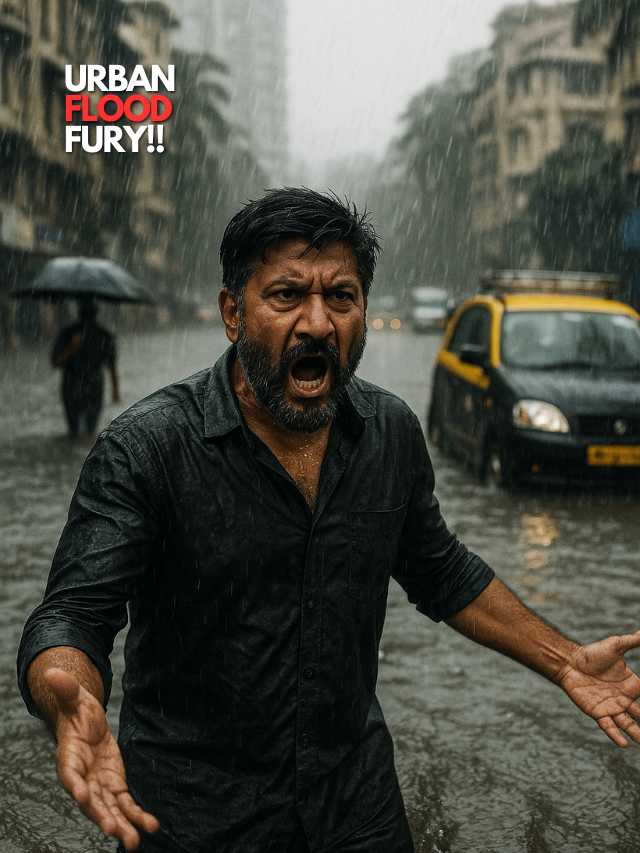Summary
- Filmmaker Vivek Agnihotri slams Mumbai’s elite neighbourhood flooding, calling India’s urban planning a “scam wrapped in a sham.”
- Over 250 mm of rainfall hits Nariman Point, disrupting traffic citywide while public transport stays afloat.
- Social media erupts with satire, anger, and calls for urgent infrastructure reform amid one of the earliest monsoons in 35 years.
Billionaire Streets Underwater: Mumbai’s Flooded Facade Exposed
The first major downpour of the season turned Mumbai’s most elite localities into makeshift canals, triggering a storm far beyond the skies — one that roared across social media. Nepean Sea Road, Pedder Road, and other high-profile zones were submerged after Monday’s heavy rains, and filmmaker Vivek Agnihotri led the online charge, branding the chaos “pathetic urbanisation.”
Sharing videos of upscale roads submerged in knee-deep water, Agnihotri’s outrage quickly went viral. His biting sarcasm — “Rs 1 lakh per sq ft for the privilege of watching your car float past your living room” — captured the surreal contradiction of luxury living colliding with third-world infrastructure. The posts were more than just venting. They reignited a national conversation about how India’s richest cities continue to sink under seasonal rain, despite world-class real estate prices and Smart City promises.
The public response ranged from raw anger to memes, with many questioning the real price of “urban development.” As Mumbai struggles to stay above water — literally — it raises a larger, unsettling truth: beneath India’s gleaming high-rises lies a city drowning in poor planning.
Pedder Road. One of Mumbai’s poshest addresses.
— Vivek Ranjan Agnihotri (@vivekagnihotri) May 27, 2025
Rs 1 lakh per sq ft for the privilege of watching your car float past your living room.
World-class pricing. Third-world drainage.
Enjoy the waterfront property. No extra charge. pic.twitter.com/WfrpSljTnQ
Urban Failure in Real Time: Monsoon Reveals Cracks in India’s Smart Cities
- Over 106 mm of rainfall recorded in Mumbai’s island city; Nariman Point saw 252 mm in 24 hours.
- South Mumbai’s most expensive areas like Pedder Road and Nepean Sea Road were inundated.
- Citizens mock high prices for “waterfront property,” while others demand Smart City accountability.
For all the pride and PR built around India’s urban renaissance, Monday’s flood scenes were painfully familiar. Pedder Road and Nepean Sea Road — synonymous with power, prestige, and sky-high real estate — became symbols of dysfunction. The irony of billionaires floating past in luxury sedans wasn’t lost on Mumbaikars.
The India Meteorological Department (IMD) had warned of heavy rains — moving from yellow to red alert in 24 hours — as the monsoon made one of its earliest entries into Maharashtra in 35 years. Yet the city, governed by India’s wealthiest civic body, was unprepared. Drainage systems buckled, roads choked, and memes exploded. Among them, the now-viral call for a new Agnihotri film: The Drainage Files.
But the humour thinned when users demanded reform. From mandatory drainage upgrades under Smart City plans to long-term solutions for solid and liquid waste management, the frustration was no longer just about rain — it was about governance. As one user put it, “World-class cities can’t run on 19th-century infrastructure.”
The Anatomy of a Flood: When Urban Planning Meets Climate Intensity
- IMD reported extremely heavy rainfall with thunderstorms and 4.88-metre high tide forecasts.
- Despite the chaos, suburban rail, metro, and bus services largely stayed operational.
- Experts warn that outdated drainage can’t cope with 100mm+ rainfall in an hour — a climate reality India must confront.
In the last 24 hours alone, the BMC reported an average rainfall of 106 mm across the island city, with south Mumbai’s Nariman Point soaking up 252 mm — a deluge by any measure. High tides of nearly 5 metres coincided with the downpour, exacerbating street flooding in low-lying areas like Colaba, Churchgate, and Byculla.
What emerged was a clear breakdown between scale and preparedness. India’s cities — especially its coastal megacities — are facing rainfall intensities that overwhelm their colonial-era infrastructure. And while climate change may explain the storm, it doesn’t excuse the stagnation. Monsoon flooding has become a structural symptom of planning failure, not just a seasonal inconvenience.
To Mumbai’s credit, transport resilience improved since previous years. Suburban rail remained largely functional, and metro and bus services reported only minor delays. But the bigger concern remains: if this is the response to the season’s first downpour, what happens when the real monsoon peaks?
Drainage and Denial: Why This Isn’t Just Another Rainy Day
Mumbai’s latest flood is not just weather — it’s a verdict on urban failure. When the city’s most expensive addresses float like slums, it exposes a deeper rot in the foundation of Indian urban planning. Vivek Agnihotri may have used satire to highlight it, but behind the punchlines is a bitter truth: Indian cities are priced for the elite but built for collapse.
As climate volatility rises, so must civic urgency. It’s not enough to slap Smart City labels on broken pipes. Drainage upgrades, flood zoning, solid waste regulation, and accountability must become non-negotiable. Otherwise, the monsoon will return each year not as relief, but as revelation.
In a city where Rs 1 lakh per square foot buys you a view of the sea — or a floodplain in disguise — the question isn’t whether we need reform. It’s whether we’re finally ready to pay the real cost of progress.



